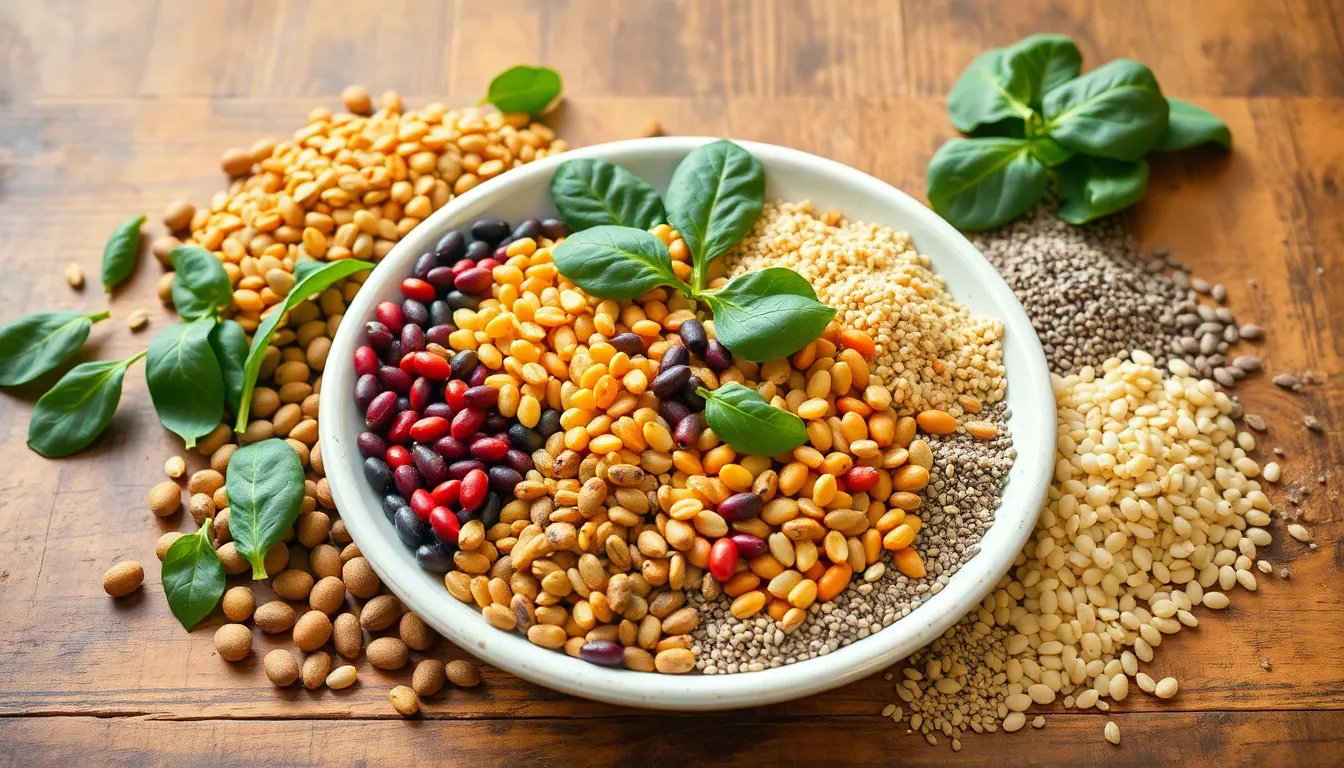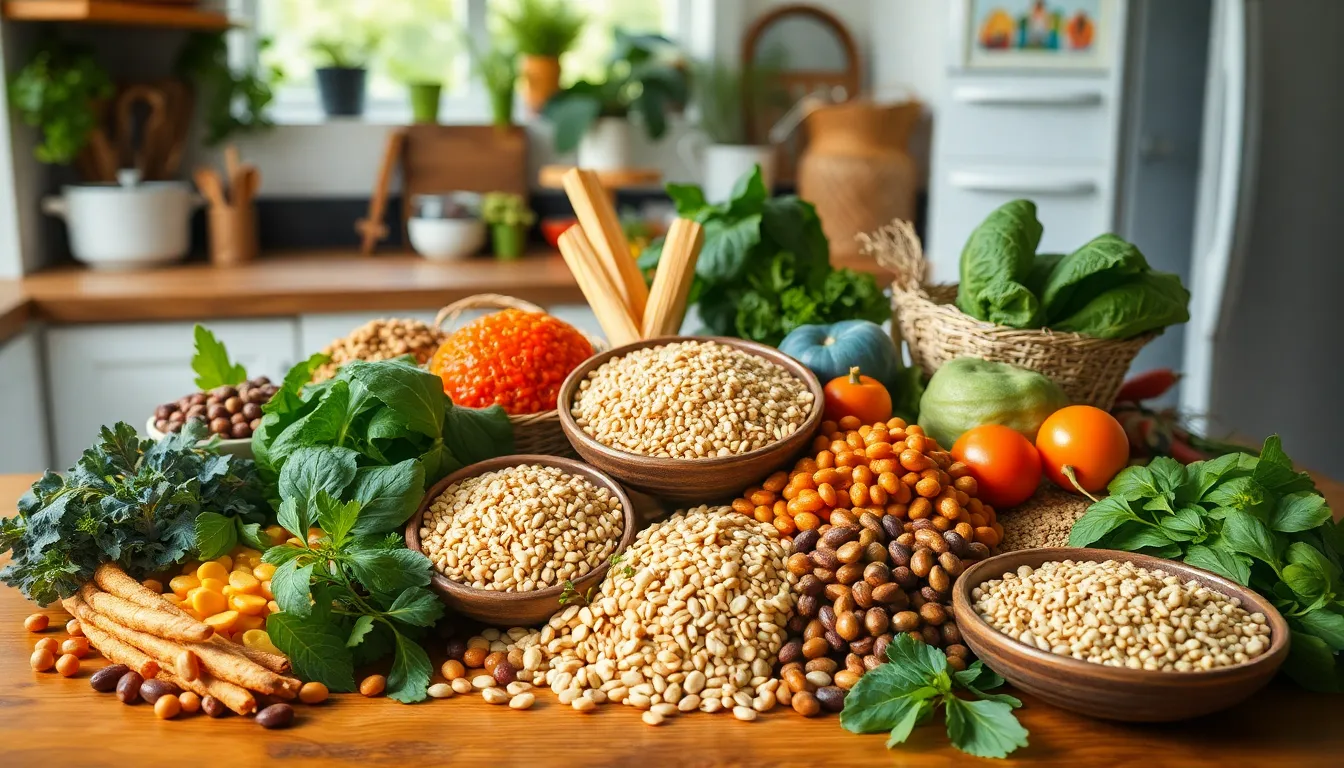In a world where kale reigns supreme and quinoa is practically royalty, plant protein sources are stepping into the spotlight. Gone are the days when protein meant just meat and dairy. Now, those vibrant veggies and hearty legumes are not just for the rabbits; they pack a serious punch. Whether you’re a dedicated herbivore or just looking to add some green to your plate, plant proteins are here to save the day—and your taste buds.
Table of Contents
ToggleOverview of Plant Protein Sources
Plant protein sources include a variety of foods that provide essential amino acids without relying on animal products. Legumes, for instance, such as lentils, chickpeas, and black beans offer higher protein content, making them staples in many diets. Grains like quinoa, a complete protein, deliver nutritious carbohydrates along with protein. Nuts and seeds, including almonds and chia seeds, contribute healthy fats and proteins.
Vegetables also play a significant role in adding protein to meals. Broccoli and spinach, despite being lower in protein, still provide quality nutrients that support overall health. Tofu and tempeh, derived from soybeans, serve as excellent meat alternatives in numerous cuisines.
Unique combinations of plant-based foods can lead to a complete protein profile. Pairing rice and beans creates a dish rich in essential amino acids essential for body functions.
The rise of plant protein sources aligns with increased awareness of health benefits and sustainable eating habits. Many consumers opt for plant-based proteins to lower cholesterol levels and reduce the risk of chronic diseases.
Emerging trends showcase innovations in plant protein, such as pea protein powders and mycoprotein derived from fungi. Products containing these proteins appeal to athletes and health-conscious individuals seeking alternative nutritional options.
Plant protein sources continue to gain traction, and knowledge of their benefits supports informed dietary choices.
Nutritional Benefits of Plant Proteins


Plant proteins provide essential nutrients crucial for overall health. Numerous sources offer significant benefits.
Essential Amino Acids
Legumes, grains, and seeds contain essential amino acids. While animal proteins provide all nine, plant proteins may lack some. Combining various plant sources, like rice and beans, assures a complete amino acid profile. Lentils and quinoa stand out for high protein content. Spinach and chia seeds contribute valuable amounts too. Properly pairing these foods ensures intake of all necessary amino acids for optimal health.
Health Benefits
Incorporating plant proteins into diets fosters various health advantages. Plant-based proteins contribute to lower cholesterol levels and reduced risk of chronic diseases. They supply fiber beneficial for digestion and weight management. Antioxidants found in legumes and nuts combat inflammation and support heart health. Studies link high plant protein consumption to longevity and improved metabolic markers. Emphasizing plant proteins also promotes environmental sustainability, aligning dietary choices with health.
Types of Plant Protein Sources
Plant protein sources offer diverse options for those seeking nutritious alternatives to animal products. Each category provides unique benefits and essential amino acids.
Legumes
Legumes are rich sources of protein, fiber, and various vitamins. Lentils and chickpeas stand out, providing about 18 grams of protein per cooked cup. These versatile foods can be utilized in salads, soups, and stews, enhancing both flavor and nutrition. Black beans, kidney beans, and peas also contribute significantly, making legumes a staple in various diets, especially vegetarian and vegan ones.
Nuts and Seeds
Nuts and seeds deliver a protein punch along with healthy fats. Almonds, for instance, offer 6 grams of protein per ounce, while chia seeds provide about 5 grams in two tablespoons. They’re easily added to smoothies, oatmeal, or salads for a nutrient boost. Pumpkin seeds and walnuts also showcase impressive protein content and add texture and flavor to different dishes.
Whole Grains
Whole grains serve as another excellent protein source, particularly quinoa, which contains 8 grams of protein per cooked cup. Brown rice and barley also contribute nutritional benefits, promoting satiety and energy. Incorporating whole grains in meals can enhance the protein profile, especially when paired with legumes or vegetables.
Vegetables
Vegetables, though not as protein-dense as other categories, still contribute valuable nutrients. Spinach, broccoli, and Brussels sprouts provide significant amounts of protein, close to 3 grams per cooked cup. They offer essential vitamins and minerals, completing a balanced diet. Pairing vegetables with legumes or grains can enhance the overall protein intake and support health goals.
Environmental Impact of Plant Protein Sources
Plant protein sources contribute significantly to environmental sustainability. They typically require less water compared to animal proteins. For example, producing one pound of beef necessitates about 1,800 gallons of water, while a pound of lentils uses only around 500 gallons.
Land use also shows a stark contrast. Animal agriculture occupies approximately 77% of global agricultural land, yet provides only 18% of the calories consumed by humans. In contrast, plant protein sources like quinoa and chickpeas can be cultivated more efficiently, minimizing habitat destruction.
Greenhouse gas emissions are a critical concern in climate discussions. Animal farming generates around 14.5% of total greenhouse gas emissions, according to the Food and Agriculture Organization (FAO). Conversely, plant protein production leads to significantly lower emissions, making it a more environmentally friendly choice for consumers.
Biodiversity benefits from a shift towards plant-based proteins. Cultivating diverse crops enhances soil health and reduces reliance on chemical fertilizers and pesticides. This approach can foster greater ecosystem resilience.
Adopting plant proteins impacts energy consumption as well. Studies show that transitioning to plant-based diets can reduce individual carbon footprints drastically. For instance, reducing meat intake by even 50% can cut dietary greenhouse gas emissions by up to 30%.
Selecting plant proteins, such as beans, nuts, and grains, supports sustainable farming practices. These options often use fewer resources and generate less waste. Emphasizing plant-based nutrition aligns with growing global efforts to promote environmental consciousness and combat climate change.
The shift towards plant protein sources marks a significant change in dietary habits. As more individuals embrace these options, they’re not only enhancing their health but also contributing to a more sustainable planet. With a variety of legumes, grains, nuts, and innovative products available, everyone can find enjoyable ways to incorporate plant proteins into their meals.
This growing trend reflects a broader awareness of nutrition and environmental responsibility. By choosing plant-based proteins, people can support their health goals while reducing their ecological footprint. As the popularity of these sources continues to rise, the future of food looks promising for both personal well-being and the planet.





